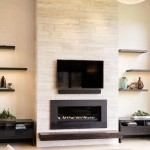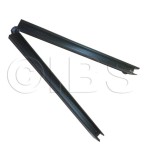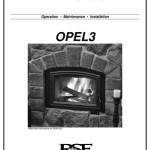Cultured Stone Fireplace Surround: Enhancing Aesthetics and Value
Cultured stone, also known as manufactured stone veneer, has become a popular choice for fireplace surrounds. Its versatility, cost-effectiveness, and aesthetic appeal make it a compelling alternative to natural stone. This article explores the benefits of using cultured stone for fireplace surrounds, discussing its various types, installation considerations, and maintenance requirements.
Aesthetic Versatility and Design Options
One of the primary advantages of cultured stone lies in its aesthetic versatility. Manufacturers meticulously replicate the textures and colors of natural stone, offering a wide array of design options. Homeowners can choose from styles that mimic fieldstone, river rock, stacked stone, and even brick, allowing for seamless integration with various architectural styles. This adaptability extends to color palettes, with options ranging from earthy browns and grays to more vibrant reds and creams. Cultured stone's inherent design flexibility enables homeowners to create a fireplace surround that perfectly complements their existing decor and personal preferences.
Furthermore, cultured stone’s consistent sizing and shapes can be advantageous. Unlike natural stone, which often requires extensive cutting and shaping to achieve a uniform appearance, cultured stone is manufactured in predetermined sizes and shapes, facilitating easier installation and reducing material waste. This predictability allows for precise design planning and ensures a professional-looking final result.
The visual impact of a cultured stone fireplace surround can significantly enhance the ambiance of a living space. It adds texture, depth, and a sense of warmth, transforming a simple fireplace into a focal point. The realistic appearance of the stone creates a natural and inviting atmosphere, contributing to the overall comfort and appeal of the room.
Cost-Effectiveness and Installation Advantages
Compared to natural stone, cultured stone offers a significant cost advantage. The manufacturing process is generally less expensive than quarrying, transporting, and processing natural stone. This cost difference can be substantial, making cultured stone a more accessible option for homeowners on a budget. The savings extend beyond the material cost, as the lighter weight of cultured stone can also reduce transportation and installation expenses.
The installation process for cultured stone is generally simpler than that of natural stone. Due to its lighter weight and consistent shape, it requires less specialized equipment and expertise. This makes it an attractive option for both professional installers and experienced DIY enthusiasts. Adhesion is typically achieved using a mortar specifically formulated for manufactured stone, ensuring a secure and durable bond to the underlying surface.
However, proper surface preparation is critical for a successful installation. The underlying surface must be structurally sound, clean, and properly prepared to receive the mortar. This may involve applying a scratch coat, a thin layer of mortar that provides a textured surface for better adhesion. Attention to detail during the preparation phase is essential to prevent future issues such as stone detachment or cracking.
The lighter weight of cultured stone also reduces the load on the supporting structure, which can be particularly important in older homes. Natural stone can be quite heavy, potentially requiring reinforcement of the foundation or framing. Cultured stone, being significantly lighter, minimizes this risk and simplifies the installation process.
Durability, Maintenance, and Safety Considerations
Cultured stone is designed to withstand the elements and maintain its appearance over time. It is typically manufactured from a mixture of concrete, aggregates, and pigments, resulting in a durable and weather-resistant material. This makes it suitable for both interior and exterior applications, including fireplace surrounds. While it should never be exposed directly to fire, it can be installed safely around a fireplace opening when proper clearances are maintained.
Maintenance requirements for cultured stone are relatively minimal. Regular cleaning with a soft brush and mild detergent is typically sufficient to remove dirt and debris. Pressure washing is generally not recommended, as it can damage the surface of the stone. Harsh chemicals and abrasive cleaners should also be avoided, as they can alter the color and texture of the material.
While cultured stone is fire-resistant, it is not fireproof. It's important to adhere to all applicable building codes and manufacturer's recommendations regarding clearances between the stone surround and the firebox opening. Non-combustible materials, such as cement board or metal studs, should be used for the underlying structure to ensure fire safety. A professional evaluation is often advisable to verify the safety and compliance of the installation.
Furthermore, it's crucial to ensure proper ventilation around the fireplace. Adequate airflow is essential for safe and efficient operation of the fireplace. Obstructions to airflow caused by the stone surround can lead to overheating and potential safety hazards. Consulting with a qualified fireplace technician is recommended to ensure proper ventilation.
Cultured stone is generally resistant to fading, but prolonged exposure to direct sunlight can eventually cause some color variation. To mitigate this, it's advisable to apply a UV-resistant sealant periodically. This sealant helps protect the stone from the harmful effects of ultraviolet radiation, preserving its original color and extending its lifespan.
The long-term durability of cultured stone also depends on proper installation. A well-installed surround will resist cracking, chipping, and detachment, ensuring years of enjoyment. Regular inspections can help identify potential problems early on, allowing for timely repairs and preventing more extensive damage.
The selection of a reputable manufacturer is paramount for ensuring the quality and durability of the cultured stone. Established manufacturers typically offer warranties on their products, providing added peace of mind. Reading reviews and researching different brands can help homeowners make an informed decision.
In summary, cultured stone offers a compelling combination of aesthetic appeal, cost-effectiveness, and ease of installation, making it a popular choice for fireplace surrounds. By carefully considering the design options, installation requirements, and maintenance needs, homeowners can create a stunning and durable fireplace surround that enhances the beauty and value of their homes.
Choosing the right type of mortar is critical for a durable and long-lasting installation. The manufacturer of the cultured stone will often recommend specific mortar products that are compatible with their stone. Using an incompatible mortar can lead to adhesion problems and premature failure of the surround. It's always best to follow the manufacturer's recommendations to ensure optimal performance.
The application of a water-repellent sealant can further enhance the durability of the cultured stone, especially in outdoor applications or environments with high humidity. This sealant helps prevent water from penetrating the stone, reducing the risk of freeze-thaw damage and efflorescence (the white, powdery deposit that can form on concrete surfaces). The sealant should be applied according to the manufacturer's instructions, typically after the stone has been properly cleaned and dried.
The placement of the stone should be carefully planned to achieve the desired aesthetic effect. Random patterns are often preferred to create a more natural look. Mixing different sizes and shapes of stone can also add visual interest. Before applying the mortar, it's helpful to dry-lay the stone to visualize the final arrangement and make any necessary adjustments.
Cutting cultured stone can be accomplished using a variety of tools, including a masonry saw, a circular saw with a diamond blade, or even a hammer and chisel. The method used will depend on the type of stone and the complexity of the cut. Safety glasses and a dust mask should always be worn when cutting cultured stone to protect against flying debris and harmful dust particles.

Cultured Stone For A Unique Fireplace Royal Oak Mi Fireside Hearth

Manufactured Stonework For Fireplace Surrounds Skilled Stone Masons

Cultured Stone Fireplaces The Stoners

Mantels Stone

Cultured Stone Fireplaces S Manufactured Fireplace Stacked Painted

Thin Cut Stone Vs Cultured Veneer The Stoners

Custom Built Fireplace Surround Install A New Mantel Hearth

Cultured Stone Fireplaces The Stoners
Stone Fireplaces Brown Dog Contracting Ltd

Cultured Stone Fireplace Surround Living Room With
Related Posts








